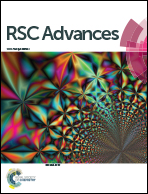A smart rhodamine–pyridine conjugate for bioimaging of thiocyanate in living cells†
Abstract
A rhodamine–pyridine conjugate, REDA-2PC, can selectively detect NCS− in human embryonic kidney 293 (HEK293) cells. DFT calculations suggest that this is due to non-covalent interactions (hydrogen bonding N–H⋯NCS−, π–π stacking) and long range electrostatic forces acting between the sulfur atom of the NCS− anion and the NEt2 unit of REDA-2PC. A visible light excitable probe allows fluorescence and naked eye detection of nanomolar NCS−, much lower than normal NCS− levels in the human body. A “lock” and “key” sensing mechanism is established and compared with the corresponding fluorescein derivative as a model compound.


 Please wait while we load your content...
Please wait while we load your content...